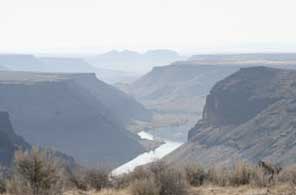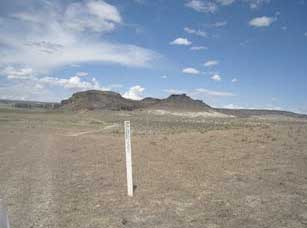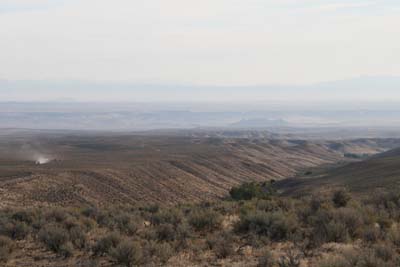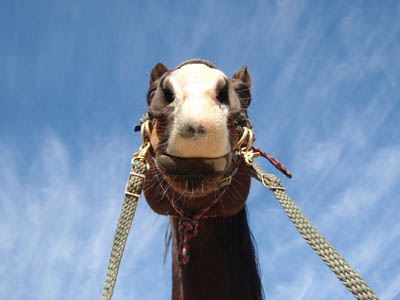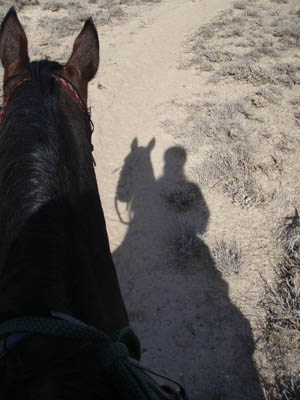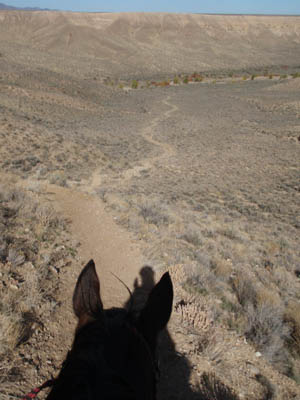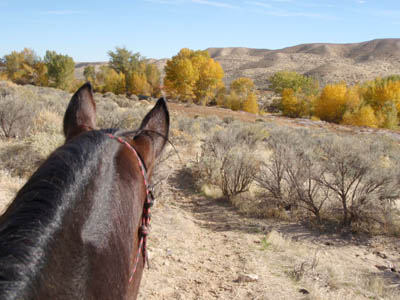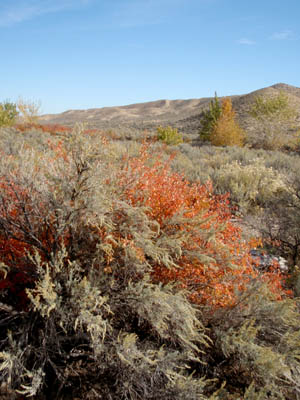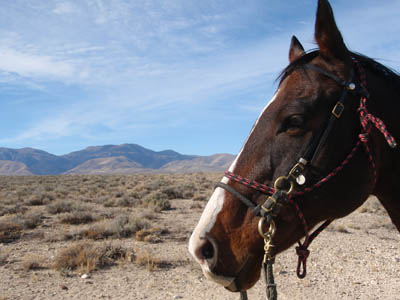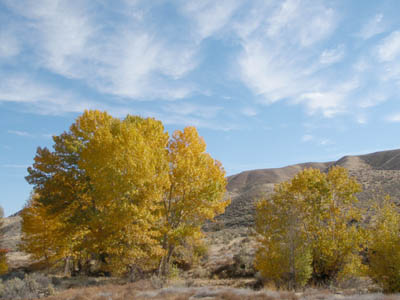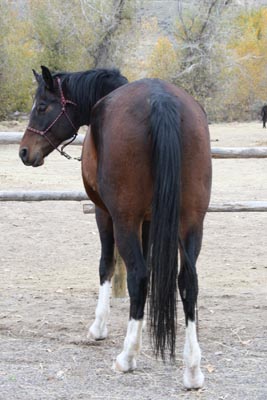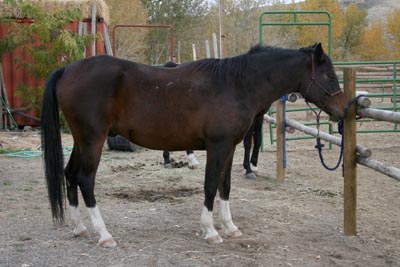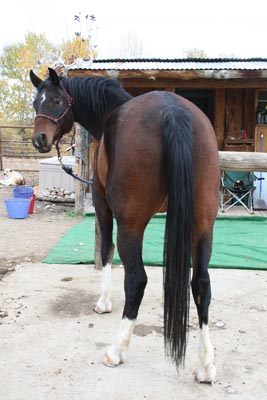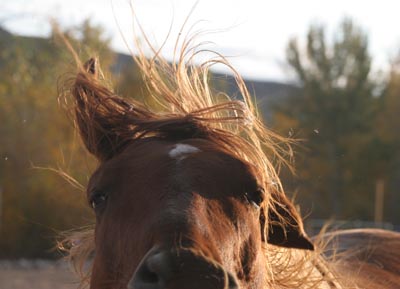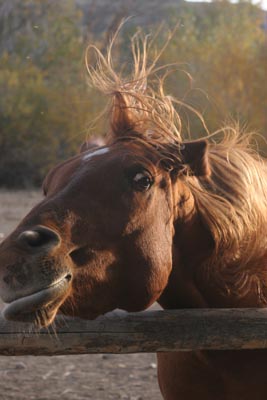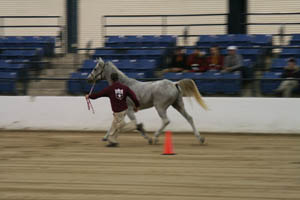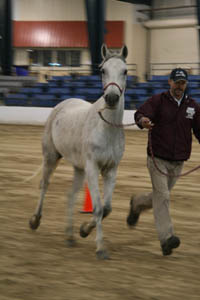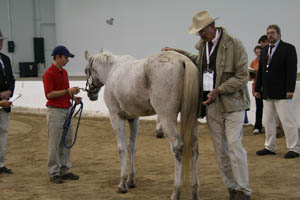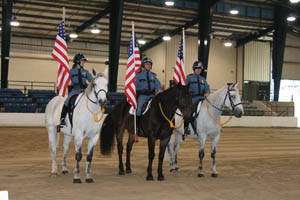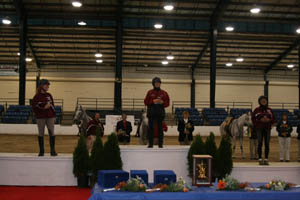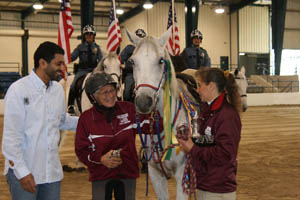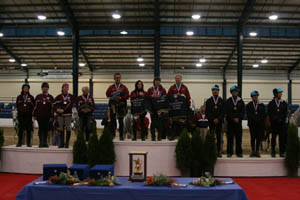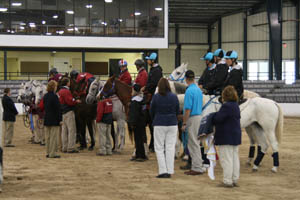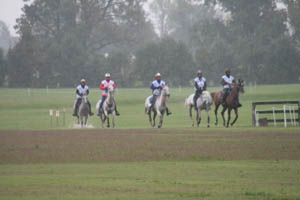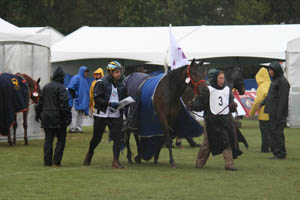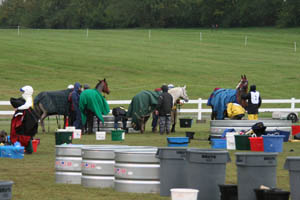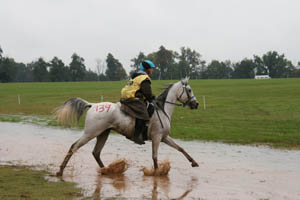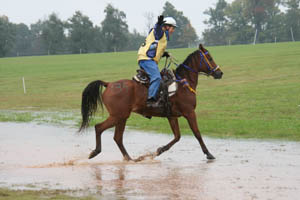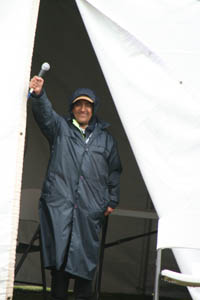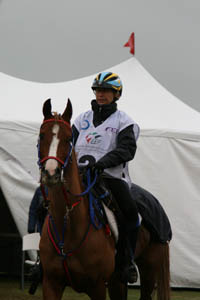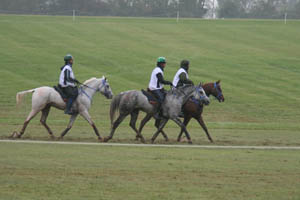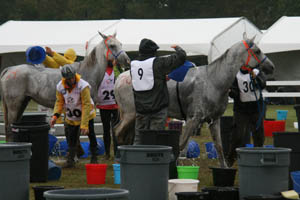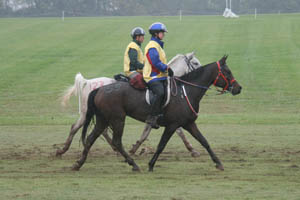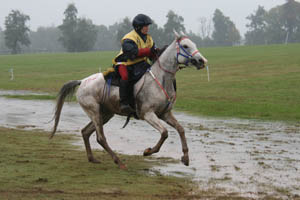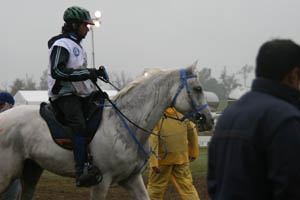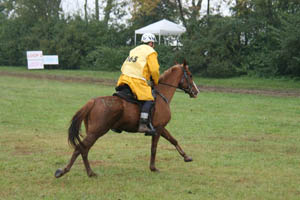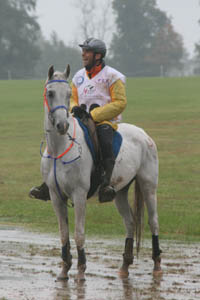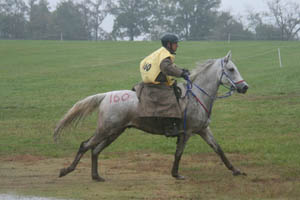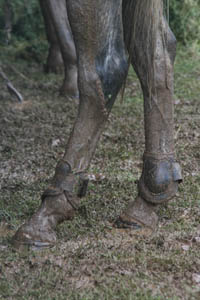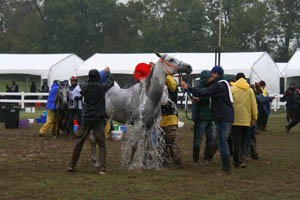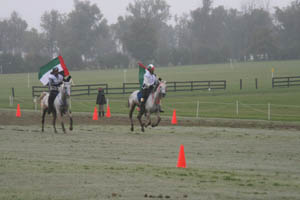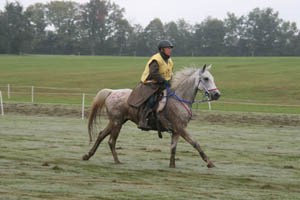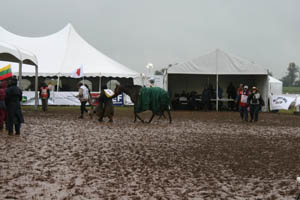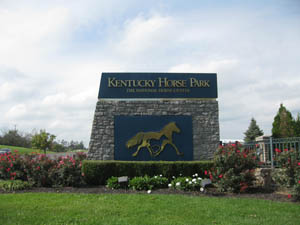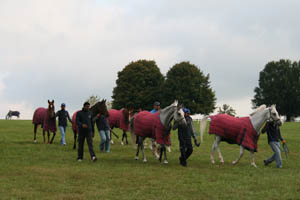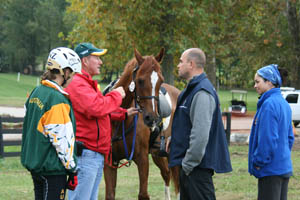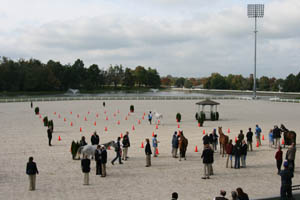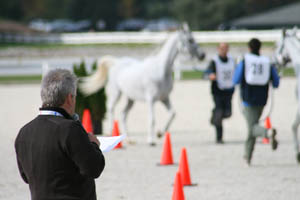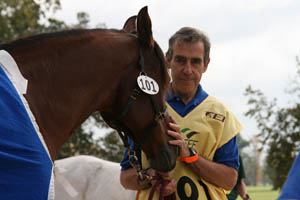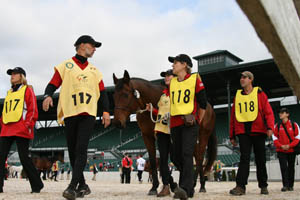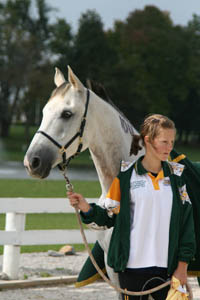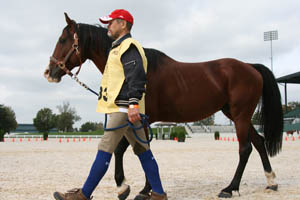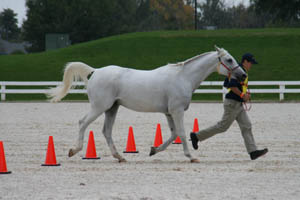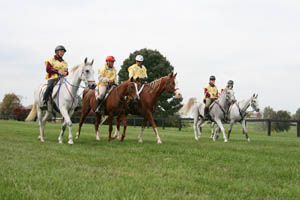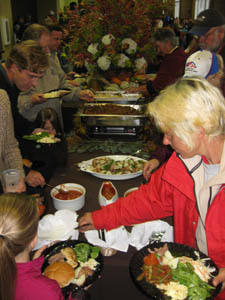Wednesday October 14 1009
Great weather for an endurance race, if you're a duck. On second thought, I didn't see any ducks anywhere around. The rain began just around the start of the 120 km ride at 7:30 AM - and didn't stop all day. Mid-40's and dumping rain most of the morning, then rain and wind, then light rain and wind, then mist and wind, more rain, more wind, and colder, dropping into the upper 30's. The condition of the course - 70% of it over mowed grass - got worse proportionally with the amount of rain: slick, with mud, that only got slicker and deeper as the day wore on.
In the vetting area, under the media and volunteer tents, it was wet - not from falling rain, but from rainwater that seeped up from the ground. Within an hour, footsteps left everything muddy, so that by noon mud was ankle deep everywhere, in the vetting and crewing areas, in the tents. By afternoon I had to walk funny because my shoes threatened to get sucked off at every step. The tracks for the horses were even worse, up to 8 inches of deep mud in some places. A little river formed at the out-timer where horses went out onto loops 3 through 6.
It was truly a test of endurance, for horses and riders, and the crews who got to stand around and freeze while they waited for their riders to come off the course.
Loop 1 - 28.7 km
Loop 2 - 39.8 km
Loop 3 & 5 - 20.4 km
Loop 4 - 31.1 km
Loop 6 - 19 km
The UAE boys, including 21-year-old Shaikh Majid bin Mohammed Al Maktoum, were the first to canter off at the start at 7:30 AM, when it was just light enough (with the heavy cloud cover and rain) to see without headlamps.
The 160 km riders were warming up in a big circle around the starting line for the 7:46 AM start. Becky Hart commented that some of them looked cold and should warm up better, even as some of the horses stopped and stood with their butts turned to the wind and rain (they'd be going straight into it). Tony Benedetti, coach for the Pac South team, joked, "It's just like California out here!" One of the riders said "My hands are frozen already!" Some of the horses wore butt blankets all day.
Off they went, an orderly start, while I tried to find a dry place for the next 1 1/2 hours that it would probably take the leaders to finish the first 28.7 km loop. The small media tent, while it had a nice heater blasting out hot air, was nowhere near the course (or near anything), nor did it have any food or water, or coffee which would have been quite welcome, so I hunkered down most of the time in the volunteers' tent, which was bigger, had coffee, another blasting heater, and I found I was able to take pictures of a bit of the finish line chute - where all the loops came in - through a divide in the tent walls. By the time riders started coming the wind was knocking the tent flaps, and therefore my camera, around so much I didn't know which was worse for my camera, the banging from the tent or the rain outside.
The heavy rain let up a bit, but by the time the first riders came in off Loop 1 at 9 AM it was back to raining hard. The first ones in were the UAE boys and Spain's Jaume Punti on Kopal de Cabirat on the 120 km, with the leader Shaikh Majid's horse Kangoo d'Aurabel averaging 18.7 km/h (11.6 mph).
Valerie Kanavy, riding the 8-year-old mare LM Parys, and her daughter Danielle McGunigal, on 8-year-old Gold Raven (an auspicious name to be sure), were the first riders from the 160 km to arrive at the vet gate, averaging 19.4 km/h (12 mph). Farzad Faryadi on 9-year-old Hot Desert Night was in hot pursuit, 3 minutes behind them, followed by Jeremy Reynolds on Sir Smith, Canadians Tara and daughter Ariel MacLeod on Cairos Summer Rmance and Driftwoods Bellanca, Gabrielle Mann on CM Big Easy, and Cheryl Dell on TR Reason to Believe.
Tara and her 7-year-old Anglo Arab mare last rode in the Ft Howes 100 in June - in similar (worse, really) weather conditions and over similar (in the morning, anyway) terrain. Ariel and her 8-year-old Arabian mare completed the 75 at Ft Howes. Maybe their horses would have an advantage today.
Conspicuously at the back of the pack on the 120 km, with only one horse beaten, was Maria Alvarez Ponton on Sahara, nearly an hour behind Shaikh Majid's lead. It seemed rather slow for the World Champion... but maybe she's a World Champion because she knows what she's doing.
Just 6 horses in both distances were eliminated after loop 1, including Penny and Alexandra Toft who retired their horses. "I've never been so scared in my life!" Penny said. They decided to stop: "These are good horses, and it's not worth the risk." It was a very expensive endeavor, flying two horses in from Australia for this ride to finish only one loop, but since I've known the Tofts, they've always put the best interest of their horses first.
Besides, 14-year-old Alexandra was near hypothermia, standing under the Australian crewing tent (open on both sides) shivering, with her teeth chattering. Madonna Harris, the High Performance Coach of the New Zealand team, here to scout out the trail with an eye to bringing a team next year, grabbed Alexandra and dragged her to the other side of the property, into the media tent, setting her down right in front of the heater. She got wrapped in a blanket, and I peeled her helmet off and stuck my wool hat on her head, and fifteen minutes later she was still shivering in front of the blasting hot air. A couple of medics were there monitoring her temperature. "That's nothing," Madonna said, "You should have seen Matthew Sample!" He was the Australian who just won the Quilty with his brother Brook in September. Madonna had brought Matthew to the heater also because he was even more frozen. Matthew warmed up enough to go out on the second loop, but his horse - DJB Boomer owned by Darolyn Butler, ended up lame.
Russian entrant Nikolay Melbard, riding Christoph Shork's DWA Express was one eliminated for lameness at the first vet check. Nikolai had been looking forward to his ride on the stallion: "He's very strong, I like that!" He said he'd be back next year to try again.
Now, what to do while waiting for the riders to complete the 2nd 39.8 km loop? There was a Hospitality Tent which had food, but was not so hospitable - it was by invitation only. Still no food or drink for the media anywhere, and the volunteer tent was under water and the heater crowded. The UAE had their own temporary building put up, and their own catering service where, if you walked on the backside road (we weren't allowed in the crewing areas either, so the only way from one side to the other was on this back road behind the UAE building) your mouth watered when you saw the hot steaming food being cooked and carried into the building. (sigh)
However, I'd had the great fortune and pleasure of meeting equine photographer and journalist
Genie Stewart-Spears, and she had the luck or foresight to have a camper in the campground which just happened to be a short distance from the vetting area. She took me in and gave me hot coffee and hot homemade soup, giving us both a little respite from the cold and rain. (She'd also given me a pair of rain pants, which saved my legs, and I'd run to Walmart the night before to pick up a $1 emergency rain poncho which was a brilliant move.)
Back into the elements to wait for the riders arriving off Loop 2. Ian Williams had been announcer during the day - it was a great way to keep up with what was going on in the ride. He kept presenting a cheery forecast, insisting "The rain is going to clear up around noon," but I was a bit skeptical, as I sloshed through the mud toward the course.
It was still - guess what! - raining at 11:33 when the riders came splashing in off Loop 2. The first 4 in were the UAE boys led by Shaikh Majid; next two were the Spanish Jaume Punti and Jordi Arboix. Second place, Yahya Sughayer Danoon's horse Medjerda, a nice eye-catching 9-year-old dark gray Arabian, was asked for a 2nd trot out, but he passed. Third place Lillig Armor, ridden by Mubarak Khalifa had a CRI of 60/40 - and that after pulsing down in 3 minutes. The first 8 riders all did this loop faster than the first one.
On the 160 km, clipping along at 20 km/h put Farzad Faryadi and Hot Desert Night in first place, a couple of minutes ahead of Valerie and Danielle.
Valerie's horse LM Parys was asked for a 2nd trot out in the vet gate, and was out for lameness - her horse had slipped and fallen on one of the paved roads on loop 2 and they both went down. LM Parys had scraped up her hind leg, although she was lame in front at the trot out. (Next morning, she was okay).
That left Farzad in first, Danielle in 2nd 6 minutes later, Jeremy Reynolds and Sir Smith moving up into 3rd 7 minutes later, followed by Mark Ibanez of Chile, riding Cheryl Van Deusen's Precious Beaunita. Next was Bob Gielen of Canada on FC Galaxy, Ellyn Rapp of Illinois on Berjo Smokey, and Jan Worthington of Illinois on Golden Lightning. Leon looked good - but then he always looks good to me.
Maria Alvarez had kicked up the pace on Sahara on this loop of the 120 km; 18 km/h (and a 2:12 to pulse down) put her in 11th place. French riders Virginie Atger and Caroline Denayer were riding together in 14th & 15th place, averaging 15 km/h.
Now the tough condition of the course was starting to take its toll - the eliminations were proportional to the rain and the deepening mud. 15 horses were pulled at Vet Gate 2 for lameness, and 1 for metabolics. Two were retired by their riders, including Carolyn Hock and her gelding GT Sando. "He passed his vet check, but I could tell he was just not moving quite right in the hind end. I conferred with my coach and the team vet and asked them for advice; we decided not to go on."
Cheryl Dell and Reason were pulled for lameness behind - and it wasn't till after the trot out that they discovered, in all that mud, they'd overlooked the fact he was missing a hind shoe. Argh! Cheryl later said that the person assigned to look after the shoes had been pulled to help elsewhere, and it was just overlooked. "Well, you live and learn." A disappointment, but, with the going so bad, maybe it was a blessing in disguise.
Just about this time, Ian Williams announced that the officials had gotten together and decided to shorten the 160 km race to 120 km, since the rain was not going to stop (maybe they'd previously been looking at the weather forecast for, say, Tahiti.) "Due to the weather and the conditions of the course" it was "in the best interest of the horses" to eliminate the last two loops.
There were mixed feelings about it - some riders were happy about the decision, because the conditions of the course really were deteriorating - mud up to 8 inches deep in some places, and the river crossings were getting deep - and only going to worsen; but some riders were disappointed, because they'd come to get their COCs. However, Jan Worthington pointed out the next day that the conditions were so bad, she didn't know if anybody would have finished the entire 160 km.
Meanwhile, the ride continued, and so did the wind and rain and cold. As veterinarian Dr Jim Baldwin said, "It's just another day in an endurance rider's life - there's a limited number, so make the best of 'em." And you didn't see too many unhappy faces, even while riders were shivering and huddled over their cups of hot tea or coffee. Some riders whooped it up as they headed out on their next loops. Mustafa Tehrani from India, riding Linda Crandell's mare LR Jasur Melika, was having a good time despite the weather, and despite the shortening of the distance of the 160 km, since he'd come aiming to get his COC. He agreed with Ian's earlier weather forecast... to some extent. "Yes there will be sunshine. In my home country of India!"
The 20.4 km Loop 3 took just over an hour for the front runners. The UAE and Spanish boys were still leading, with Shaikh Majid staying in front by a couple of minutes, averaging 19.2 km/h on that loop. Jaume Punti retired his horse at the vet check, which moved Leo Steinbruch of Brazil, riding Stars A Flame - owned by Dian Woodward & Christoph Shork - up to 6th place.
Danielle McGunigal, in the 160 km, was actually only 2 minutes behind Shaikh Majid - she'd made up 14 minutes on the trail. Ellen Rapp and Smokey arrived just 3 minutes behind her. Farzad Faryadi was in 8th, but he turned up on the eliminations sheet at the timer. If you didn't see him go out, you wouldn't know he was still going. I didn't find that out till after the top 10 or so had finished the ride, and it wasn't corrected till later on the printouts. It was a surprise when everyone saw his name on the pull list, and it was another surprise to find out he ultimately finished 8th!
By now the rain was lighter, but the wind was stronger and colder. Crewing was either Hit or Miss, Luck, or an Art. Used to dumping water on a horse to cool it down in warm weather, what does the crew do when it's 40* and raining outside, with a wind chill below 30*? The horses would come in steaming from their hard efforts in the mud, with heart rates above the (I believe it was) 64 criteria. Some crews would toss blankets on the horse's butt and not pour water on them at all and just let the rain and cold wind do the cooling. Some crews poured water (it was all cold water) on the neck and shoulders, keeping the butt blanketed. Some crews poured water over the entire horse, and some horses kept their tails clamped to their butts. There was a fine line between cooling a horse down and cooling it down too much to where they then had to be warmed up. Some horses spent their hold times shivering while they ate and rested. Some riders spent their breaks shivering under coats and horse blankets.
Twenty-one eliminations at Vet Gate 3, 10 for lameness, 1 for metabolics, one for "Lack of Time", one "Horse very tired". 8 of them were "retired by the rider", including Gabrielle Mann and Big Easy. Gabrielle echoed a common sentiment, "It just wasn't worth risking hurting my horse." Canadian Ariel MacLeod was another who stopped here; her mom Tara's horse had been pulled for lameness at Gate 2.
And the track did keep getting worse, especially any common trail. Kim Fuess, who ended up with two of her horses finishing the 160 km - Ben whom she rode, and Rushcreek Laramie, whom Charisse Glen rode - recounted later, "I thought the first loop was bad, but when I was out on Loop 2, I thought, 'Wow, Loop 1 was nothing!', but when I was on Loop 3, I thought 'Wow, Loop 2 was nothing, this is bad!', and when I was on Loop 4, I thought, 'Loop 3 was nothing, THIS is bad!'. It just kept getting worse all day!"
Taking it all in stride, and I daresay, enjoying himself, was Bill Stevens from Montana. Bill and Jan (the Chief Steward for the ride) put on the Fort Howes ride in Montana in June, where, this year, it rained, sleeted, snowed, and hailed - and was about 10 degrees colder than in Lexington today. Bill was jolly, zooming around in his golf cart checking the course (he was the hands-on, mud-on, 'loop 2 manager' but I saw him everywhere), spreading changes of clothes all over the volunteer tent to 'dry' - he really was having a good time. "This is nothing like Montana - it's not even snowing yet!"
As the front runners went out on their fourth and last loop of 31.1 km, the rain let up a bit (although it never stopped), but the wind picked up and the temperature dropped. As we waited for the first finishers to come in between 3:30 and 4 PM, even I, a cold lover, was getting pretty frozen (cold, wet, muddy feet and ankles all day, and a wet head to boot now), and was trying to shelter from the wind a bit beside the volunteer tent. I felt for those UAE crew boys, who looked frozen in their Tshirts and sweatshirts, (not one of them wearing a coat) covered only with a thin plastic raincoat that looked suspiciously like the $1 raincoat I'd just gotten at Walmart. Kentucky in October was a loooong way from the Dubai desert!
Just in case there was a galloping finish (i.e. if anybody was silly enough to have to do that), the officials moved the last 50 yards of track over a few lanes, since the original lane was now deep in mud and very slippery from previous horse tracks.
The first two finishers to come cantering in were on the 120 km, Shaikh Majid and Ahmed Salem Ali Sutal Al Sabousi, waving big UAE flag poles, their horses looking fresh. Ahmed's horse presented first after 6 minutes and got a completion, followed by Shaikh Majid's horse after 9 minutes, giving him the win.
Next across the line was Danielle McGunigal in the 160 km. Gold Raven took 13 minutes before she was taken in to be vetted through. After the first two finishers in the 120 km passed their vet check, all the announcing by Ian Williams stopped; so unless you were at the exit of the vet ring, you didn't know who passed or failed.
Without the announcing it was a bit hard to keep up with things - who was coming in to the finish, who was in the crewing area (especially hard to tell riders and crews apart in their layers of rain gear), who was entering the vet gate, who passed and completed the race.
I was at the finish line and never even heard whether Danielle's horse had passed the vet check or not (and was therefore the winner), so I had to ask someone, who'd watched the horse trot out, if Danielle had completed.
Next year there's supposed to be a Jumbotron, to show riders on course, and to project statistics in the vet gates, so everybody will know what's going on during the ride. It was quite nice having Ian announcing what was going on, but when he stopped, it was like turning a light off and having to feel your way around in the dark.
The next finishers in the 120 km were UAE's Kanoon in 3rd, Spain's Jordi Arboix in 4th, UAE's Khalifa in 5th, UAE's Sultan Ahmad Sultan bin Sulayem in 6th, and Maria Alvarez in 7th. Leo Steinbruch of Brazil was next followed by the two French girls Caroline Denayer and Virginie, still riding together on their leased American horses.
In the 160 km Ellen Rapp cantered across the finish line in second, (she had backed way off the pace on this last loop), and Jan Worthington and Leon were 3rd. After Leon passed the final vet check, Jan did a happy dance in the mud, and Grace Ramsey, the Central Team coach and co-owner/trainer of Leon, did a Yahoo too - "We got third!"
Jeremy Reynolds came under the finish line after having gotten off Smitty and leading him much of the last part of that last loop - but Smitty was so tired at the final vet check, he wouldn't trot out. Four times they tried trotting him, and not for anything would Smitty move out of a walk. He was listed as "lame" though "Horse Very Tired" (as was listed for another horse) should have been for Smitty also. Jeremy had done as much as he could, getting off him to walk part of the last loop, but Smitty was just done - the mud got him too today.
Just 14 of 34 starters finished the 120 km, and 31 of 61 finished the 160-shortened-to-120 km. (Chikako Nishiyama is listed as a starter in the 120 km, but she didn't start; and Cici Butler is listed as a starter in the 160 km, but she didn't start. There could possibly be more, but I don't think so.)
A pretty gloomy rate, but then it was a pretty dismal day with dismal footing. Shaikh Majid didn't think so, but then he's a youthful 21. I'll share a quote handed to the media the next day, for a diplomatic point of view: "There wasn't any hard part, other than the ground being a bit slippery. Other than that, it was excellent. There wasn't anything wrong or bad." Mubarak Khalifa (5th in the 120 km) said of the weather, "Endurance riders are used to riding in all kinds of weather, so this is normal."
A couple of horses were treated as a precaution, either by vet's choice or rider's choice, and all were reported to be doing fine the next day.
The 2009 Kentucky Cup really was a true test event - a test of the course (Emmett Ross will have some more planning to do next year, and, as he said, "Praying"), of communications (a bit erratic at times - places and times and scheduling of things changed and much of it was luck if you heard those changes or not), and most of all an extreme test of the riders and horses competing (and their tenacious crews).
Just about everybody came away with something learned for next year, including me: bring Muck Boots, another $1 raincoat, and maybe a couple of Ducks.
